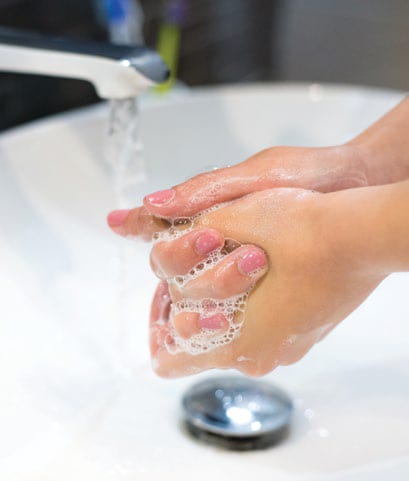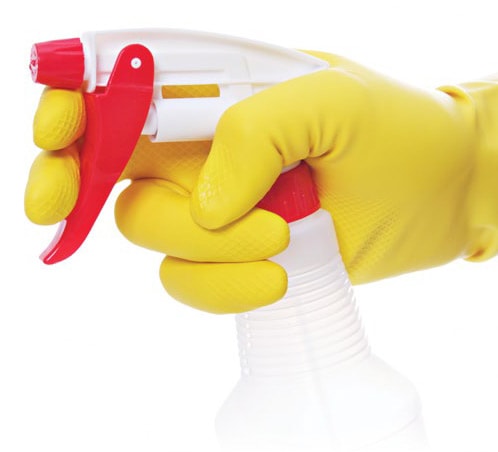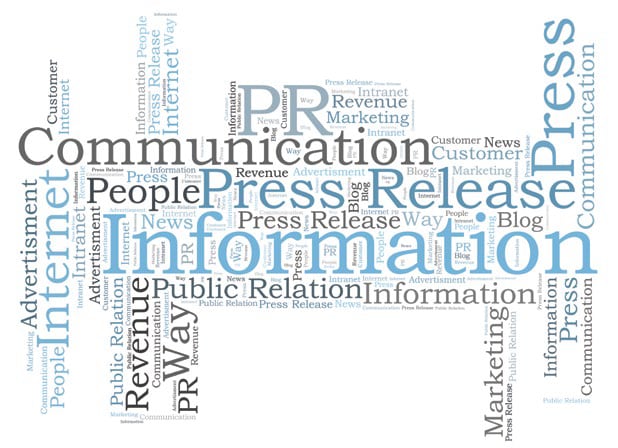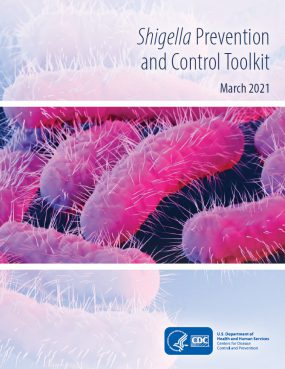Shigella Prevention and Control Toolkit

Shigellosis is a highly contagious diarrheal disease caused by a group of bacteria called Shigella. Outbreaks of Shigella infection can occur from environmental,1 food,2, 3 water,4–9 or person-to- person10 exposure (see References section). Anyone can get sick from Shigella infection. However, groups that may be at particular risk include children,11–19 travelers,20, 21 men who have sex with men,22–37 and people with weakened immune systems. 35, 38–42 Shigella bacteria have increasing rates of antimicrobial resistance both in the United States43 and globally.20, 30, 34, 44–47
The information in this toolkit is intended to help state and local health departments respond to suspected or confirmed cases, clusters, or outbreaks of Shigella infection.
These materials include information on:
- Data collection
- Responding to an outbreak of Shigella infection
- Sanitation, hygiene, and cleaning
- Fact sheets, palm cards, and letter templates to aid communications with the public, including materials specific to key populations
Data Collection
In the event of a suspected or confirmed Shigella case, cluster, or outbreak, a hypothesis-generating questionnaire may be useful. A hypothesis-generating questionnaire could collect data on case demographics, clinical and treatment information, medical history, and exposure information, such as travel, recent activities, sexual health and history, occupation, and childcare center or school attendance.
An example of a hypothesis-generating questionnaire focused on food is the National Hypothesis Generating Questionnaire (NHGQ).
If you do not currently have access to a hypothesis-generating questionnaire for shigellosis, CDC can provide assistance, including sharing hypothesis-generating questionnaires used by other state and local health departments.
Responding to a Shigella Outbreak
Reviewing how other jurisdictions have approached Shigella outbreaks can be useful to inform outbreak investigation and response efforts. The following references (listed in the References section) discuss Shigella outbreaks that have occurred in different settings, among different populations, and across different modes:
- Settings
- Populations
- Modes
- Intensified Control Measures for Shigellosis Outbreaks in a Childcare Setting
- Recreational Water Illness Outbreak Response Toolkit
- CDC Field Epidemiology Manual
- CDC’s Crisis and Emergency Risk Communication Manual
- Shigella Hypothesis Generating Questionnaire – English [PDF – 8 pages] | Español [PDF – 9 paginas]
Sanitation, Hygiene, and Cleaning
Sanitation, hygiene, and cleaning are recommended behaviors to prevent and control Shigella outbreaks. The following materials provide the best available information to help state and local health departments promote sanitation, hygiene, and cleaning behaviors as part of comprehensive prevention and control efforts.
Handwashing

Frequent handwashing helps reduce the spread of Shigella infection and is an intervention applicable to a range of outbreak settings and modes of transmission.
Recommended Handwashing Steps
- Wet your hands with clean, running water (warm or cold), turn off the tap, and apply soap.
- Lather your hands by rubbing them together with the soap.
Be sure to lather the backs of your hands, between your fingers, and under your nails. - Scrub your hands for at least 20 seconds. Need a timer? Hum the “Happy Birthday” song from beginning to end twice.
- Rinse your hands well under clean, running water.
- Dry your hands using a clean towel or air dry them.
Handwashing in Childcare Settings
Schedule and supervise handwashing of all children during the following times:
- Upon arrival at the facility
- After outdoor play
- Before meals and snacks
- Upon leaving the childcare setting
Also supervise handwashing after diaper changes and using the bathroom.
When Hands Should Be Washed
- Before, during, and after preparing food
- Before eating food
- Before and after caring for someone who is sick
- After using the toilet
- After blowing your nose, coughing, or sneezing
- After touching garbage
- After changing diapers or cleaning up a child who has used the toilet
- After touching an animal, animal feed, or animal waste
- After handling pet food or pet treats
- CDC handwashing website (English and Spanish)
- Handwashing health promotion materials (posters, fact sheets, social media, videos)
- Handwashing trainings and educational resources
Safe Diapering
Maintaining hygienic diaper changing practices is essential to reducing the spread of Shigella infection. Even a microscopic amount of feces (poop) can contain millions of germs.
Recommended Diapering Steps
- Prepare
- Cover the diaper changing surface with a disposable liner.
- If you will use diaper cream, dispense it onto a tissue now.
- Bring your supplies (e.g., clean diaper, wipes, diaper cream, gloves, plastic or waterproof bag for soiled clothing, extra clothes) to the diapering area.
- Clean Child
- Place the child on the diapering surface and unfasten the diaper.
- Clean the child’s diaper area with disposable wipes. Always wipe front to back!
- Keep the soiled diaper/clothing away from any surfaces that cannot be easily cleaned. Securely bag soiled clothing.
- Remove Trash
- Place used wipes in the soiled diaper.
- Discard the soiled diaper and wipes in the trash can.
- Remove and discard gloves, if used.
- Replace Diaper
- Slide a fresh diaper under the child.
- Apply diaper cream, if needed, with a tissue or a freshly gloved finger.
- Fasten the diaper and dress the child.
- Wash Child’s Hands
- Wash the child’s hands with soap and water and place him or her in a safe, supervised area.
- Clean Up
- Remove the liner from the changing surface and discard in the trash can.
- Wipe up any visible soil with damp paper towels or a baby wipe.
- Wet the entire surface with disinfectant; make sure you read and follow the directions on the disinfecting spray, fluid, or wipe. Choose disinfectant appropriate for the surface material.
- Wash Your Hands
- Wash your hands thoroughly with soap and water.
- CDC diapering website
- Diapering in the home (English and Spanish)
- Diapering for childcare providers
- Diapering in emergency settings (English and Spanish)
- Diapering in shelters
Facility Sanitation and Cleaning
Surfaces and objects in childcare centers and other facilities often have germs that can cause illnesses like diarrhea. In the event of an outbreak, surfaces may need to be cleaned and disinfected more often to reduce the chance of spreading Shigella infection. Childcare centers and other facilities can consider creating a schedule that helps facility staff routinely clean surfaces and objects.
Cleaning, Sanitizing, and Disinfecting
Cleaning, sanitizing, and disinfecting are all ways to remove germs from surfaces and objects in childcare centers and other facilities, but some of these methods do not remove all germs. Generally, a cleaning process uses soap and water only, but sanitizing and disinfecting require using stronger chemicals or bleach. Generally, disinfecting solutions kill more germs than sanitizing solutions.
| Method | How To | Result |
|---|---|---|
| Cleaning |
|
|
| Sanitizing |
|
|
| Disinfecting |
|
|
Information in this table was adapted from Caring for Our Children: National Health and Safety Performance Standards; Guidelines for Early Care and Education Programs.99
How to Use Bleach Safely

- Replace bleach often. Bleach loses strength over time. (For best results, replace bleach each month with new bleach.)
- Mix bleach solutions safely. If you use a bleach solution, you should:
- Add bleach to the water (DO NOT add water to bleach).
- Make a new batch of the mixture each time you need it.
- DO NOT mix bleach with any cleaner containing ammonia. This can result in harmful chlorine gas.
- Keep children away from cleaning products. Do not use cleaning products when children are present or in close proximity to children. Keep bleach and bleach solutions in locked cabinets that are inaccessible to children.
- Protect your own health. Use cleaning, sanitizing, and disinfecting products in an area with adequate ventilation to prevent inhalation of potentially harmful fumes.
- Be aware of health hazards related to bleach. Bleach may irritate skin and eyes, and has the potential to trigger asthma. If you are concerned about potential hazards related to bleach, use a disinfectant that says EPA-approved instead. Get more information on EPA-registered disinfecting products.
¼ cup of bleach + 1 gallon of cool water
OR
1 tablespoon of bleach + 1 quart of cool water Add the bleach to the water
1 tablespoon of bleach + 1 gallon of cool water Add the bleach to the water
Recipes adapted from the ABCs of Safe and Healthy Child Care: A Handbook for Childcare Providers.100
Communication
During an outbreak of Shigella infection, communication with the public should be open and regular. Keep all key stakeholders and constituents informed with next steps and useful information, and if necessary schedule periodic communications. CDC’s Crisis and Emergency Risk Communication (CERC) Manual and CERC in an [PDF – 1 page] Infectious Disease Outbreak Manual [PDF – 1 page] can be used to guide communication and messaging strategies during an outbreak of Shigella infection.
Internal Communication
- Identify all key partners within your organization.
- Designate clearly defined roles based on every partner’s departmental roles and strengths.
- Within your agency, designate a shared space to store outbreak materials, develop a communication distribution list, and establish the most efficient ways to communicate outbreak updates.
- Depending on the magnitude of the outbreak and the degree of involvement with other agencies, the department may decide to follow the Incident Command System to assist in command, control, and coordination of the emergency response.
Communications with Other Health Departments or Agencies
- Determine a schedule for regular conference calls with established key contacts. Use these calls to keep everyone informed, plan next steps, and share information. This should be done on a case-by-case basis; every outbreak or event will have different communication needs.
- Decide how to share information, such as e-mail, state communication systems, or national communication systems, such as Epi-X. Make sure all communication channels work.
- Consider using HAN announcements or Clinician Outreach and Communication Activity (COCA) to reach clinicians.
Public Communication
Press Releases, Internal Talking Points, and Social Media

- When appropriate, press releases should include information about:
- Who is affected by the outbreak or event
- What the pathogen or issue is
- Where the outbreak or event is occurring
- When it happened
- What is being done to solve the issue(s) and steps people can take to protect themselves
- Keep press releases brief and use clear and simple language. A sample press release template [PDF – 1 page] is available from the CDC website.
- Consider posting press releases to the agency’s website and linking to them from the agency’s social media platforms.
- Determine the case definition and the number of cases for release in a public case count.
- In uncertain circumstances, it is acceptable to leave room for changing case counts, as ongoing tests are verified or case definitions change. For example, consider using language such as “more than” or “fewer than (x) cases,” rather than giving exact numbers.
- Identify a clearance chain for reviewing all public information before release.
- Share a draft of the press release with established key contacts and partners before release.
- Develop internal talking points with your public information officer (PIO). Consider including predetermined answers to questions that may be asked by reporters, the public, or other agencies once a press release is issued.
- Share internal talking points with established key contacts and partners for message consistency.
- Determine how and when to inform the public that the outbreak or event is over and the health risk has subsided.
- Determine the best channels for communicating with the public. These could include press releases, press conferences, website updates, social media messages, or emergency alerts.
Media Relations
- Identify and establish a working relationship with your PIO.
- Work with your PIO to develop and maintain a distribution list of local news agencies and reporters with current contact information.
- Use this list to send news and updates about outbreaks, recent events, and other information.
- Discuss and agree upon a schedule for sending updates to the media during an outbreak or event.
- This should be done on a case-by-case basis; every outbreak or event will have different reporting needs.
- Identify a primary spokesperson for media interviews. Identify a secondary spokesperson for backup in case the primary is not available. Share this information with your PIO.
Letters to Parents and Other Populations
Communicating with parents and other affected populations is an essential part of the outbreak response to ensure they feel informed about the outbreak and know the steps they can take to protect their health and the health of others. A letter template to parents and to a general population is provided in Appendix A and Appendix B of this toolkit.
Health Communication Materials
CDC has developed several health communication materials to assist in the dissemination of key information on Shigella and sanitation and hygiene.
This toolkit includes links to a range of materials, including fact sheets, infographics, palm cards, and social media messages. Some materials are available in multiple languages, and a selection of printed materials can be ordered from CDC-INFO On Demand.
Communication Resources

CDC Shigella Website
- English (www.cdc.gov/shigella)
- Spanish (www.cdc.gov/shigella/esp)
Adult Shigella Infographic
- English (www.cdc.gov/shigella/do-you-have-diarrhea.html)
- Spanish (www.cdc.gov/shigella/esp/diarrhea.html)
Sexually Active Adult Shigella Infographic
- English (www.cdc.gov/shigella/are-you-sick-with-diarrhea.html)
- Spanish (www.cdc.gov/shigella/esp/infographic-partner-diarrhea.html)
Sexually Active Adult Shigella Palm Cards
- English (www.cdc.gov/shigella/palm-cards.html)
- Spanish (www.cdc.gov/shigella/esp/palm-cards.html)
CDC Shigella Website for Sexually Active People
- English (www.cdc.gov/shigella/audience-sexually-active.html)
- Spanish (www.cdc.gov/shigella/esp/audience-sexually-active.html)
Handwashing Promotion
- English (www.cdc.gov/handwashing/fact-sheets.html)
- Spanish (www.cdc.gov/handwashing/esp/fact-sheets.html)
Pediatric Shigella Infographic
- English (www.cdc.gov/shigella/child-diarrhea.html)
- Spanish (www.cdc.gov/shigella/esp/child-diarrhea.html)
- Arabic, Chinese, French, Somali, Tagalog, Vietnamese (bottom of page www.cdc.gov/shigella/child-diarrhea.html)
Safe Diapering in Childcare Settings
Safe Diapering in the Home
- English (www.cdc.gov/hygiene/childcare/in-the-home.html)
- Spanish (www.cdc.gov/hygiene/es/in-the-home-esp.html)
- Arabic, Chinese, French, Somali, Tagalog, Vietnamese
(Bottom of page www.cdc.gov/hygiene/childcare/in-the-home.html)
Social Media Messages
- Tweets and Facebook Posts (www.cdc.gov/shigella/social-media-library.html)
Appendix A. School or Childcare Center Letter to Parents
Dear Parent or Guardian,
A student in your child’s class has been diagnosed with shigellosis. Therefore, there is a possibility that your child has been exposed to this disease. Shigellosis is a highly contagious diarrheal disease caused by a group of bacteria called Shigella. Shigella can spread through person-to-person contact and contaminated food or water . Symptoms may include severe or bloody diarrhea, fever, and stomach cramps.
Parents of children or anyone with symptoms of shigellosis should contact their health care provider for diagnosis and treatment. Careful attention to handwashing with soap and water is the single most important action to decrease spread of Shigella. The attached fact sheet provides more information on shigellosis, including the signs and symptoms, ways it spreads, and the time it takes to get sick after exposure to the germ.
If any friends or family have any of these symptoms, encourage them to talk to their healthcare provider . <STUDENTS OR CHILDCARE CENTER ATTENDEES> with shigellosis may be kept out of <SCHOOL OR THE CHILDCARE CENTER> until symptoms have stopped and the <STUDENT OR CHILDCARE CENTER ATTENDEE> has a note from the healthcare provider to return to <SCHOOL OR THE CHILDCARE CENTER>.
If you have any questions, please contact <SCHOOL OR CHILDCARE CENTER DEPARTMENT> at <SCHOOL OR CHILDCARE or CENTER DEPARTMENT TELEPHONE NUMBER>.
Sincerely,
<SCHOOL OR CHILDCARE CENTER ADMINISTRATOR NAME>
Appendix B. Organization Letter to Affected Patrons
<ORGANIZATION HEADING>
<ORGANIZATION TELEPHONE NUMBER>
Dear <ORGANIZATION NAME> patron,
A <ORGANIZATION NAME patron or employee> has been diagnosed with shigellosis. Therefore, there is a possibility that you have been exposed to this disease. Shigellosis is a highly contagious diarrheal disease caused by a group of bacteria called Shigella. Shigella can spread through person-to-person contact and contaminated food or water. Symptoms may include severe or bloody diarrhea, fever, and stomach cramps.
Anyone with symptoms of shigellosis should contact their health care provider for diagnosis and treatment. Careful attention to handwashing with soap and water is the single most important action to decrease spread of Shigella. The attached fact sheet provides more information on shigellosis, including the signs and symptoms, ways it spreads, and the time it takes to get sick after exposure to the germ.
If any friends or family have any of these symptoms, encourage them to talk to their healthcare provider. <ORGANIZATION NAME employees> with shigellosis may be kept out of <ORGANIZATION NAME> until symptoms have stopped and the <ORGANIZATION NAME employee> has a note from the healthcare provider to return to <ORGANIZATION NAME> .
If you have any questions, please contact <ORGANIZATION DEPARTMENT NAME> at <ORGANIZATION DEPARTMENT TELEPHONE NUMBER>.
Sincerely,
<ORGANIZATION OFFICIAL NAME>
